Irish Suffragettes at the time of the Home Rule Crisis
Published in 20th-century / Contemporary History, Features, Home Rule Crisis, Issue 1 (Spring 1996), Revolutionary Period 1912-23, Volume 4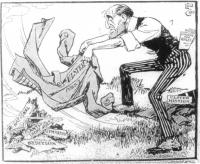
Sir Edward Carson(vigorously fanning sparks):They liken my conduct to the mad suffragettes’, do they? Sure I wish I could make a fire blaze as they can anyway!
(votes for Women, June 1913)
Irishmen do not need to have indicated to them the hardship of being governed by those alien to them in temperament, ideals and traditions. An Englishmen they say can never understand the needs of a country like Ireland. How strange then that all men should be considered gifted with the wonderful power of sympathetic interest which enables them to so easily understand the needs of women.
Rose Lavery, New Irish Review 1908
From the headlines for the years 1912-14 it would seem that there was only one issue in Irish politics. Home Rule and its progress or otherwise dominated all local and national papers in Ireland. A simple survey of general history books for this dramatic period would lead one to believe that the women’s movement had passed Ireland by, that there had been no Irish suffragettes. While English women were bravely dodging the ‘cat and mouse’ act and hurling objects at politicians, women in Ireland were, it seemed, fulfilling their natural roles of making tea and comforting their husbands. Women are generally invisible in the histories and textbooks of the period. The two women who might appear, Countess Markievicz and Maud Gonne, were neither representative of women at this time nor very interested in the woman’s movement. The suffrage movement in Ireland was simply, as one newspaper headline of the time put it, ‘an amusing side-show’.
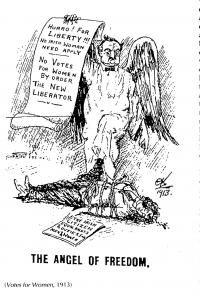
(Votes for Women, 1913)
Irish suffrage societies
In fact, there was a strong and active group of educated women and men who questioned all aspects of Irish society and who campaigned for women’s suffrage. Among such were Edith Somerville and Violet Martin (Martin Ross?) recorders not only of the Anglo-Irish lifestyle but also president and vice-president of the Munster Women’s Franchise League. Martin was a unionist and totally opposed to Home Rule, while Somerville was a somewhat idiosyncratic nationalist. Born into the Anglo-Irish ascendancy both were irritated and bored by the limits placed on women by society. In March 1883 Somerville had written, ‘began a very original book, “My trivial life and misfortune by a plain woman”‘. The Irish Women’s Franchise League (IWFL), the Irish equivalent of Emmeline Pankhurst’s Women’s Social and Political Union (WSPU) was founded by a husband and wife. Hanna and Francis Sheehy-Skeffington would be an unusual pair even by today’s standards. Both were vegetarian pacifists who in a very unusual step took each others names on marriage. Together they founded the Irish Citizen, the first feminist newspaper in Ireland. They were both nationalists but believed that any Home Rule Bill must provide equally for men and women.
The Irish suffrage societies reflected those found in England and there were strong links between them. The WSPU with its militant actions tended to dominate the headlines but it is easy to forget that there were many other moderate and peaceful societies. Louie Bennet’s Irish Women’s Suffrage Society had a long history and strong links with Millicent Fawcett’s National Union of Women’s Suffrage Societies. In 1908 the New Ireland Review reported that ‘there are first the women who want the vote at any price; there are second the women who don’t want the vote at any price; and third the women who want the vote but are prepared to pay only a certain price for it’. Whatever their choice of action—from discussion groups to protect meetings—all Irish suffrage societies were open to accusations of disloyalty. The only thing that united Redmond and Carson was their opposition to women’s suffrage. A campaign against either leader would bring forth condemnation. What could be more important than either securing or defeating Home Rule!
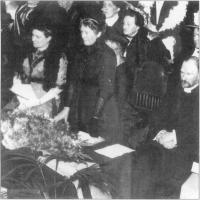
Lady Dufferin(center) at the first AGM of the Ulster Unionist Women’s Council with its president, the Duchess of Abercorn(left),18 January 1912.
(Hogg Collection, Ulster Museum)
Strained relations
The relationship between the English and Irish suffragettes became strained at times due to the actions of the Irish or Unionist parties or the interference of the Pankhursts’ WSPU in Ireland. The 1910 elections had left Asquith and the Liberals dependant on the support of Redmond and the Irish Party. The deal brought benefits but also obligations to both. Asquith was a determined opponent of women’s suffrage and had long been the main target of the WSPU newspaper Votes for Women. Redmond, as the Manchester Guardian reported, found that ‘it is necessary for the Irish Party in the interests of Home Rule to save the Liberal ministry from the disruptive effects of women’s suffrage’.
This was no sacrifice for Redmond as he was totally opposed to women’s suffrage anyway. Besides more traditional objections Redmond worried that giving women the vote might affect support for his party. If the vote was given as proposed to wealthy women with property, the Unionists would surely benefit. In 1912 he put off a deputation of women from the Irish Women’s Franchise League (IWFL) with a different argument, saying the matter was not included in the proposed Home Rule bill because if it were to be granted, it should be the decision of an Irish not an English parliament. On the Unionist side, Carson was equally intransigent on the issue, and although Craig was a supporter of the women’s cause he was not prepared to challenge the determined stand of his leader. The Unionists could only have one aim—the defeat of Home Rule and nothing could be allowed to distract from that. In October 1912 the Irish Citizen (the Irish equivalent of Votes for Women) condemned Carson. Under the headline ‘the male covenant’ it declared that ‘it’s clear—and Unionist women should take note—that Sir Edward Carson is as much an enemy to his countrymen as Mr. Redmond’.
In England the policy of the militant suffragettes was quite clear—suffrage first and before all else. If the Irish Party were responsible for the defeat of suffrage bills such as the Conciliation bill then they should be opposed. Christabel Pankhurst with her usual enthusiastic tactlessness urged, ‘No votes for women, no Home Rule’. Her sister Sylvia considered this approach fantastic and doomed to failure and tried to persuade the WSPU to leave the Irish question to Irish women. Despite this advice the WSPU decided that there would be ‘a fight to the death between suffragists and the National Party’.
This moved the WSPU clearly into the unionist camp but where did that leave nationalist suffragettes in Ireland? The issue was debated in the pages of the Irish Citizen. Helen Morony from Limerick wrote: ‘I am sure we will find it hard to forgive ourselves if our actions injure the party that has the means of placing Home Rule almost within our grasp’. Mrs Coate from the Newry Suffrage Society agreed with some irony that ‘we must do nothing to endanger the sacred cause of Home Rule. Therefore we must be doormats and feather cushions, and so make everything pleasant and easy to enable the men of Ireland to win their freedom’. However she added, ‘but Ireland with her womanhood enslaved will not be free’. Mrs Chambers from the Belfast Suffrage Society argued that ‘we women have put off the matter of woman’s suffrage too often already’. However, Mary McSwiney from the Munster Suffrage Society put the dilemma very clearly when she wrote, ‘I do not put party first; I put Ireland first. I quite agree that there can be no free nation without free women; but the world—women included—has taken some thousands of years to realise that fact. Three years more in our very exceptional circumstances will not hurt us.”
Hatchet thrown at Asquith
The Irish Women’s Franchise League began its militant campaign in Dublin on 13 June 1912. Eight members, including Hanna Sheehy-Skeffington, smashed the windows of the GPO, the Custom’s House and Dublin Castle. The women were all arrested and sentenced to between a month and six months in jail. There was little general support for them, even when they went on hunger strike. The following year Asquith came to Dublin to be received as generous benefactor. The IWFL braved the taunts of the welcoming crowds to demonstrate. They shouted suitable slogans and threw confetti at the visiting Prime Minister. However two members of the WSPU, Mary Leigh and Gladys Evans, unknown to the Irish suffragettes, had come over from England to keep up their campaign on Asquith. Not content with confetti, they threw a hatchet at Asquith. Luckily it was blunt and only grazed him on the ear but Irish nationalists were horrified. The action of the two English suffragettes did not helped their Irish sisters. They had been less violent and had not been part of the attack on Asquith, but they were now tarred with the same brush, an English brush that seemed anti-Home Rule.
In Ulster the situation was no easier for suffragettes with unionist husbands or fathers. A Mrs McCracken, a regular contributor to the Irish Citizen and the Belfast News Letter attacked unionist women: ‘Their services have been of the nature of a self-denying ordinance. Never once, so far as I know, have they formulated any demand on their own behalf or that of their own sex’. Strange as it may seem unionist women were criticised by nationalist women for not signing the Solemn League and Covenant alongside their men and signing a ‘female’ version instead. It was not the content that was the issue here but the idea that women should need their own declaration or petition. The constitution of the Ulster Women’s Unionist Council made it clear that only one question was on the agenda—’all other questions in which individual members may be specially interested, shall be subordinated to the single issue of the maintenance of the Legislative Union’.
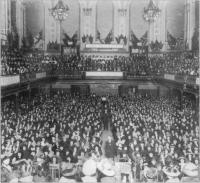
Ulster Unionist Women’s Council meeting, Ulster Hall, Belfast, 18 January 1912. (Ulster Museum Collection)
Ulster Unionist support?
In 1913 the Unionist Council leadership was planning to set up a provisional government for Ulster in the event of Home Rule becoming law. Suffrage societies in Ulster were just as anxious as their nationalist counterparts for inclusion in such a parliament. The English suffragettes also saw this as another opportunity in Ireland. On the 11 September 1913 the Irish daily papers carried the news that WSPU was to start a campaign of destruction in Ulster aimed at persuading Carson to include women in his provisional government. The very next day a letter from Dawson Bates, secretary of the Unionist Council, to Mr Hamill, the secretary of the Ulster Unionist Women’s Council appeared in the press:
Dear Mr. Hamill,
I am authorised to inform you that the draft articles of the Provisional Government already approved of by this Council include the franchise for women on the basis of the register for local government purposes. In taking this step the Council are merely following the policy which they consistently adopted of co-operating with your council. …submit names of women willing to act on various committees…to ensure those who have so heartedly supported us in the past will be immediately co-opted with a view to their taking their proper share in the management of the affairs of Ulster.
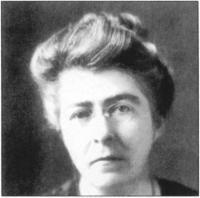
Hanna Sheehy- Skeffington(1877-1946),
Irish Women’s Franchise League.
Was it really true that possibly the most conservative part of the United Kingdom was going to give votes to women first? Mrs George McCracken writing the Irish Citizen could not understand why Carson, the last man from whom they expected support, had departed from his professed opinions. Overall the Irish Citizen gave a guarded welcome to the Bates letter and wondered whether the credit should go to the WSPU, the Ulster suffragists or to the Ulster Unionist women. Rather than celebration and congratulation Bates’ letter prompted more ill-feeling between the English and Irish suffragettes. The WSPU claimed that their threatened campaign had forced Carson to give in rather than risk violence at such a delicate time. The Irish suffragettes, north and south, naturally resented this assertion. Dora Mellone refuted the WSPU claim for all the credit and declared
If they (the WSPU) understood Ireland a little better, they would realise how utterly impossible such a thing is. The north of Ireland at the present, is not in the mood to be affected by broken windows or threats of disturbed meetings. Such attempts would merely end in the temporary defeat of the suffrage movement. Rightly or wrongly, the north just now is prepared to risk more than broken windows for the sake of its political creed and men who are prepared to face civil war are not afraid of a burnt house or two.
The general resentment of the English invasion was summed up by Louie Bennett.
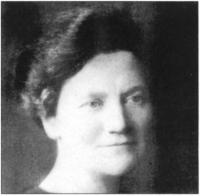
Mary McSwiney, Munster Women’s Franchise League.
We Irish women must resent the independent interference of any English organisation in our affairs. English suffragettes cannot do any good work for us unless they co-operate with us and allow themselves to be guided by our more intimate knowledge of the Irish people and Irish affairs.
But what of the Ulster Women’s Unionist Council to whom the offer of enfranchisement had been made? What was their reaction? Their delight was certainly well contained. On 24 September the first official response appeared in the form of a letter from Lady Londonderry, president of the UWUC:
Dear Mr. Bates,
I have to thank you for your letter of the 10 September, and in accordance with the terms of the Declaration signed by us last September, the Ulster Women’s Unionist Council is prepared to do such work as may be deemed helpful by the men’s Ulster Unionist Council
Why such reluctance? An examination of Theresa Londonderry’s correspondence and the minutes of the UWUC provide some explanation. Amongst these items we find the Dowager Marchioness of Dufferin and Ava writing to her friend and fellow Council member that
There is a great deal of feeling about Mr. Bates’s letter, and the suffragettes are triumphant. Others wrote
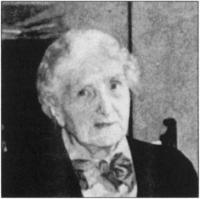
Louie Bennett (1870-1956), Irish Women’s Suffrage Federation.
to suggest that we ‘veto’ the resolution. So I come to the conclusion that it would be best entirely to ignore the suffrage part of the letter.
It was clear that no other issue was going to be allowed to divert unionist women from their immediate task of defeating Home Rule; no discussion, no debate, no further information on the offer made by the Unionist Council, was to be allowed. Even visiting speakers were warned to avoid any reference to it—’We hope that your committee will be
most careful when advertising any of our speakers to make it quite clear that they are concerned solely with the question of the Union’. It was not surprising therefore that the Suffragette was able to report that at a Carson rally in Newry ‘we found that many amongst the audience were as yet unaware of the fact that women were to be included in the Provisional Government of Ulster’. Finally in the spring of 1914 Carson, besieged by a deputation from the WSPU, confirmed that he had never really intended to give women the vote on any terms in a provisional government. Carson argued that
they were fighting for the same treatment for the men of Ulster as the men of England were getting, and the women of Ulster would get the same treatment as the women of England get; he would not ask for special treatment for Ulster women, it would be inconsistent on his part to do so since he had never agreed with the suffrage movement. Nor could he make such a demand on his party as they were divided on the subject.
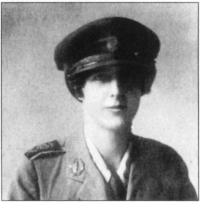
Lady Londonderry(1879-1959), Ulster Women’s Unionist Council.
As the Irish Citizen was quick to point out, Carson did not find it inconsistent to ask for special treatment for Ulster when it came to Home Rule, only when it came to women’s suffrage.
WSPU declares war
The WSPU reacted immediately with a declaration of war. Unlike the IWFL Dublin campaign in 1913 which had attacked public buildings, the WSPU set out to damage as much private property as possible (see enclosed table of destruction). The police attempted to check the outbreak of incendiarism by arresting the Ulster organiser, Miss Dorothy Evens and the Honorary Secretary, Miss Midge Muir. On the 3 April their flat in University Street, Belfast was raided and explosive substances were found. The pair created uproar in court, five days later, when they demanded why James Craig was not appearing on the same charge.
Hanna Sheehy-Skeffington (IWFL), although resentful of the WSPU invasion, echoed their query when pointing out the contrast between ‘the recognition of the efficacy of Sir Edward Carson’s militant campaign and the persistent refusal of the government to concede anything to the militant women’. Carson and Craig after all were threatening civil war. Votes for Women echoed this frustration in an article entitled ‘The government pot and the Ulster kettle’, pointing out that ‘women have been harried and persecuted, imprisoned and tortured for acts not one quarter so criminal and threatening to the good order of the community as those of Sir Edward Carson’s armed following’. Public disgust with the WSPU blitz was demonstrated in an incident which occurred in Ballymena in July 1914. Two Austrian ladies on a motoring tour of Ireland were mistaken for suffragettes. They were surrounded by a hostile crowd who shouted anti-suffragist abuse at them. Forced to take refuge in a shop they were eventually rescued by the local UVF commander who escorted them to their hotel.
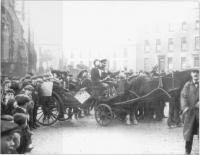
Anti-suffrage demonstration in Strabane, County Tyrone,
c.1910.(Cooper Collection,PRONI)
Epilogue
The First World War first interrupted and then brought great changes to both Home Rule and women’s suffrage. A grateful British government surprised by what women could do when asked, rewarded them with the vote in 1918. In Ireland Sinn Fein’s victory had superseded the Home Rule debate and the new Dáil Éireann gave women the vote. Unionist women had of course received their reward in 1918, and when their own version of Home Rule came with Stormont they loyally turned out to vote as always in support of their men. It is ironic to note that in 1918, Carson writing to his patron and friend, Theresa Londonderry, felt able to claim some credit for the advancement of women in politics:
I hope you will bear in mind how necessary it is that the women should have their full share in the organisation of Ulster. I did my best when I was over to lay the foundation of this policy.
In September 1920 the final issue of the Irish Citizen appeared. It had maintained its independent stance throughout the war attacking, for example, both Ireland’s involvement and the failure of the Irish Volunteers to include women as full members. In 1916 Francis Sheehy Skeffington was murdered by a British soldier as he tried to prevent looting during the Easter Rising. Hanna, hardened by events, became more actively republican and opposed the Treaty in 1921. By the early 1920s she recognised the demise of the women’s movement in Ireland. As she said herself, perhaps now they had the vote women were content that all battles had been won. Furthermore she recognised that the national struggle continued to overshadow all else.
Vivien Kelly is Assistant Advisory Officer in History for the Southern Education and Library Board, Armagh
Further reading:
M. Ward, Unmanageable Revolutionaries: Women and Irish Nationalism, 1996
R. Cullen, Smashing Times : A History of Irish Women’s Suffrage Movement 1889-1922
















